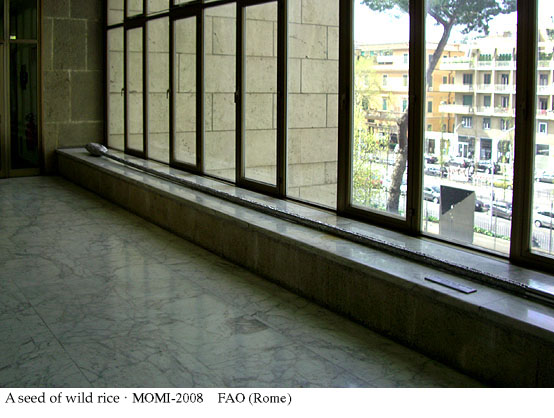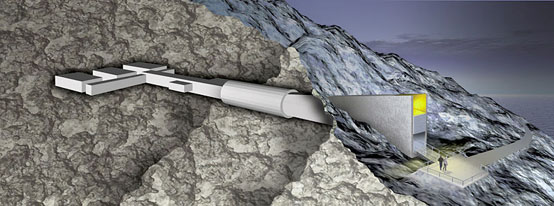 Some
time ago, I read in the evening edition of the Asahi Shimbun newspaper of March
1 that, on February 26, a "Noah's Ark for Plants" had been established
on the island of Spitzbergen in the Svalbard Islands, the northernmost part of
Norway. Known as the Svalbard Global Seed Vault, it was located at a place 130
meters above sea level and 120 meters below ground in bedrock. This vault has
the capacity to store 3,000,000 varieties of seeds and grains. The facility was
built by the Global Crop Diversity Trust (GCDT), an autonomous organization within
the Food and Agriculture Organization of the United Nations (FAO) with the cooperation
of the Norwegian government as one solution for planetary environmental problems
such as global warming, ecological breakdown, and the imbalance in food supply
and demand. The idea that seeds might be preserved for a long time (200 years)
even if the earth is contaminated by nuclear material is based on rational Western
thinking. It would not have occurred to the Japanese, who are blessed with an
abundant natural environment to which they respond emotionally. To commemorate
the completion of the vault, Japanese sculptor Mitsuaki Tanabe (69, lives and
works in Yokohama) has installed a sculpture at the headquarters of GCDT in the
FAO building in Rome, Italy. Tanabe attended the unveiling ceremony of the monument
on April 1. I heard about this sculpture from the artist and thought about its
meaning. Some
time ago, I read in the evening edition of the Asahi Shimbun newspaper of March
1 that, on February 26, a "Noah's Ark for Plants" had been established
on the island of Spitzbergen in the Svalbard Islands, the northernmost part of
Norway. Known as the Svalbard Global Seed Vault, it was located at a place 130
meters above sea level and 120 meters below ground in bedrock. This vault has
the capacity to store 3,000,000 varieties of seeds and grains. The facility was
built by the Global Crop Diversity Trust (GCDT), an autonomous organization within
the Food and Agriculture Organization of the United Nations (FAO) with the cooperation
of the Norwegian government as one solution for planetary environmental problems
such as global warming, ecological breakdown, and the imbalance in food supply
and demand. The idea that seeds might be preserved for a long time (200 years)
even if the earth is contaminated by nuclear material is based on rational Western
thinking. It would not have occurred to the Japanese, who are blessed with an
abundant natural environment to which they respond emotionally. To commemorate
the completion of the vault, Japanese sculptor Mitsuaki Tanabe (69, lives and
works in Yokohama) has installed a sculpture at the headquarters of GCDT in the
FAO building in Rome, Italy. Tanabe attended the unveiling ceremony of the monument
on April 1. I heard about this sculpture from the artist and thought about its
meaning.
|
 The
monument is made of stainless steel, measuring 9 meters long and weighing 250
kilograms. The title is A seed of wild rice - MOMI 2008. The artist has
made a number of monumental sculptures which show a consistent concern for the
natural environment and advocate in-situ conservation of wild rice and plant diversity.
He uses stainless steel, one of the strongest materials produced by contemporary
technology, and the sophisticated technique of arc air gouging to give form to
momi, or wild rice seeds. The current work, which was made in Joetsu and shipped
from the port of Tokyo, emphasizes its monumentality with a simple form and a
rough surface that looks extremely hard and durable. The
monument is made of stainless steel, measuring 9 meters long and weighing 250
kilograms. The title is A seed of wild rice - MOMI 2008. The artist has
made a number of monumental sculptures which show a consistent concern for the
natural environment and advocate in-situ conservation of wild rice and plant diversity.
He uses stainless steel, one of the strongest materials produced by contemporary
technology, and the sophisticated technique of arc air gouging to give form to
momi, or wild rice seeds. The current work, which was made in Joetsu and shipped
from the port of Tokyo, emphasizes its monumentality with a simple form and a
rough surface that looks extremely hard and durable.
 In
Japan, the rice-growing culture was imported from other countries, so wild rice
has never been cultivated. The seeds of wild rice are characterized by a long
whisker extending from the small seed. Tanabe created large, symbolic versions
of this form and showed them in solo exhibitions in 1989 and 1992. After the exhibitions,
the artist arranged for these pieces to be installed in institutions related to
rice agriculture outside Japan. His artworks were placed with the Zhejian Provincial
Museum in China, the Thai royal family, and the International Rice Research Institute
(IRRI) in the Philippines. This led him to produce site-specific works, in which
the form and scale are designed to fit the site. He proceeded to make gigantic
artistic representations of wild rice and the moment of sprouting of the seed
for the Pathum Thani Rice Research Center in Thailand in 1997, IRRI in the Philippines
in 1994, and the Indian Council of Agricultural Research in 2002. Around the time
Tanabe's monument was erected in Thailand, the queen herself took the lead in
organizing a project for in-situ conservation of wild rice. These activities eventually
led the artist to Rome. In
Japan, the rice-growing culture was imported from other countries, so wild rice
has never been cultivated. The seeds of wild rice are characterized by a long
whisker extending from the small seed. Tanabe created large, symbolic versions
of this form and showed them in solo exhibitions in 1989 and 1992. After the exhibitions,
the artist arranged for these pieces to be installed in institutions related to
rice agriculture outside Japan. His artworks were placed with the Zhejian Provincial
Museum in China, the Thai royal family, and the International Rice Research Institute
(IRRI) in the Philippines. This led him to produce site-specific works, in which
the form and scale are designed to fit the site. He proceeded to make gigantic
artistic representations of wild rice and the moment of sprouting of the seed
for the Pathum Thani Rice Research Center in Thailand in 1997, IRRI in the Philippines
in 1994, and the Indian Council of Agricultural Research in 2002. Around the time
Tanabe's monument was erected in Thailand, the queen herself took the lead in
organizing a project for in-situ conservation of wild rice. These activities eventually
led the artist to Rome.
 A serious
problem in the real world is that more than half of the Earth's population eats
rice as their main food source but production cannot keep up with the growth of
population. The world is faced with a food crisis as famine and hunger become
more prevalent. Rice-producing countries are all dealing with a shortage of agricultural
land and water and abnormal weather conditions, making it difficult to increase
production. This is also true of Japan, where domestic reserves are decreasing.
We hear about the critical condition of food resources in fragmentary reports,
but many Japanese are not fully aware of it. Tanabe's proposal is a warning of
the crisis awaiting Planet Earth, inhabited by 6.6 billion people, and he is making
proposals to deal with further problems. This is why it is meaningful to apply
the non-scientific endeavor of art to the study and research activities of experts
in agriculture, genetics, the world economy, food, and environmental pollution.
Because specialization is increasing in every field today, it is becoming more
difficult to get a real sense of what is happening. That is why I believe that
philosophy and art have a very important role to play. A serious
problem in the real world is that more than half of the Earth's population eats
rice as their main food source but production cannot keep up with the growth of
population. The world is faced with a food crisis as famine and hunger become
more prevalent. Rice-producing countries are all dealing with a shortage of agricultural
land and water and abnormal weather conditions, making it difficult to increase
production. This is also true of Japan, where domestic reserves are decreasing.
We hear about the critical condition of food resources in fragmentary reports,
but many Japanese are not fully aware of it. Tanabe's proposal is a warning of
the crisis awaiting Planet Earth, inhabited by 6.6 billion people, and he is making
proposals to deal with further problems. This is why it is meaningful to apply
the non-scientific endeavor of art to the study and research activities of experts
in agriculture, genetics, the world economy, food, and environmental pollution.
Because specialization is increasing in every field today, it is becoming more
difficult to get a real sense of what is happening. That is why I believe that
philosophy and art have a very important role to play.
|





